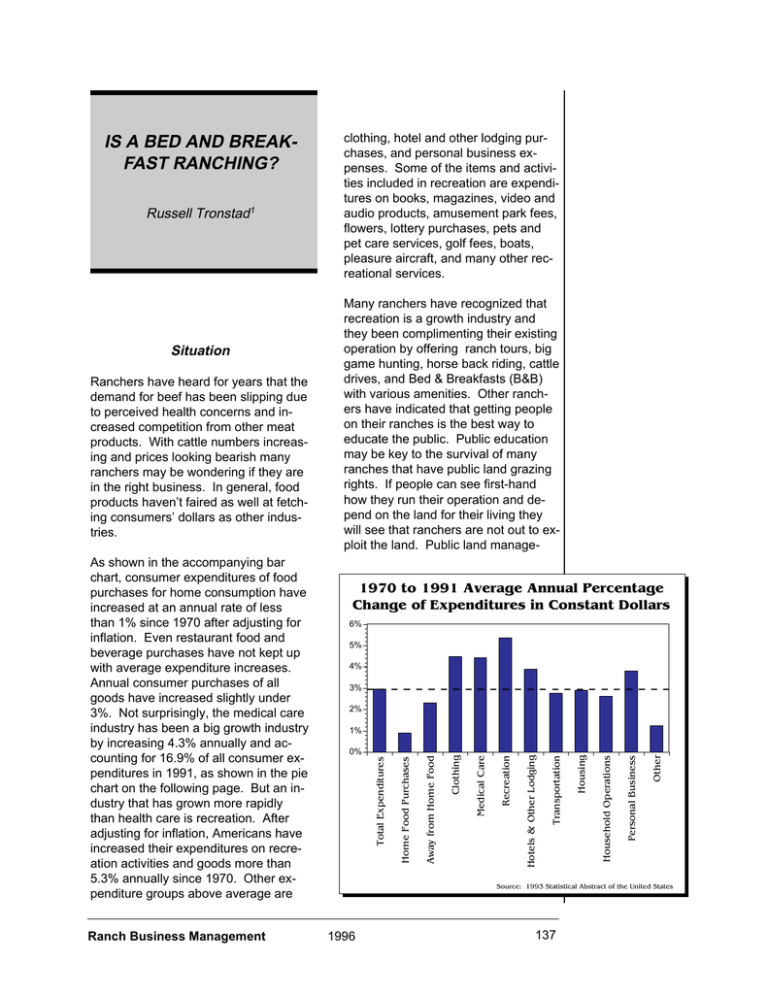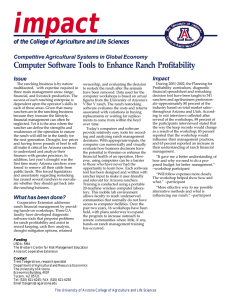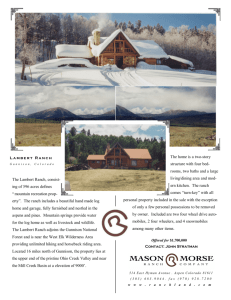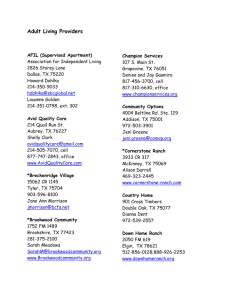IS A BED AND BREAK- FAST RANCHING?
advertisement

Ranch Business Management 1970 to 1991 Average Annual Percentage Change of Expenditures in Constant Dollars 6% 5% 4% 3% 2% Other Personal Business Household Operations Housing Transportation Hotels & Other Lodging 0% Recreation 1% Medical Care As shown in the accompanying bar chart, consumer expenditures of food purchases for home consumption have increased at an annual rate of less than 1% since 1970 after adjusting for inflation. Even restaurant food and beverage purchases have not kept up with average expenditure increases. Annual consumer purchases of all goods have increased slightly under 3%. Not surprisingly, the medical care industry has been a big growth industry by increasing 4.3% annually and accounting for 16.9% of all consumer expenditures in 1991, as shown in the pie chart on the following page. But an industry that has grown more rapidly than health care is recreation. After adjusting for inflation, Americans have increased their expenditures on recreation activities and goods more than 5.3% annually since 1970. Other expenditure groups above average are Clothing Ranchers have heard for years that the demand for beef has been slipping due to perceived health concerns and increased competition from other meat products. With cattle numbers increasing and prices looking bearish many ranchers may be wondering if they are in the right business. In general, food products haven’t faired as well at fetching consumers’ dollars as other industries. Away from Home Food Situation Many ranchers have recognized that recreation is a growth industry and they been complimenting their existing operation by offering ranch tours, big game hunting, horse back riding, cattle drives, and Bed & Breakfasts (B&B) with various amenities. Other ranchers have indicated that getting people on their ranches is the best way to educate the public. Public education may be key to the survival of many ranches that have public land grazing rights. If people can see first-hand how they run their operation and depend on the land for their living they will see that ranchers are not out to exploit the land. Public land manage- Home Food Purchases Russell Tronstad1 clothing, hotel and other lodging purchases, and personal business expenses. Some of the items and activities included in recreation are expenditures on books, magazines, video and audio products, amusement park fees, flowers, lottery purchases, pets and pet care services, golf fees, boats, pleasure aircraft, and many other recreational services. Total Expenditures IS A BED AND BREAKFAST RANCHING? Source: 1993 Statistical Abstract of the United States 1996 137 Personal Consumption Expenditures for 1991 Food Purchases for Home Consumption 10.5% Away from Home Meals & Beverages 5.1% Clothing 6.7% Other 6.6% Medical Care 16.9% Personal Business 8.2% Household Operations 11.4% Recreation 7.5% Hotels & Other Lodging 1.2% Housing 14.8% Transportation 11.3% Total of $ 3,887.7 Billion Source: 1993 Statistical Abstract of the United States ment issues will continue to be debated over what is the most appropriate stocking rate and fee for grazing public lands. Strategies Some ranchers have been able to educate the public first-hand on how they operate their ranch while capitalizing on some of the recreational demands that tourists are demanding. For example, Peggy Monzingo of Benson, Arizona started up a ranch B&B a few years ago in order to educate the public on environmental and public land issues. “Ranchers need to do their part in educating the public first-hand and correctly since so many are misinformed,” says Peggy. She has a love for the land and a concern for how encroaching urbanization and public policies can disrupt an ecosystem. These factors ultimately impact both the aesthetic appeal and economic viability of the land. The B&B has given her an opportunity to educate individuals one-on-one in the field, meet many interesting people, and receive some “positive cash flow” for the first time in her life. Positive cash flow is non-existent in the checkbook ledger of most ranchers. Wyoming has an established ranch B&B industry with over 60 registered in the 1994 Wyoming Homestay & Outdoor Adventures (WHOA) guide. WyoRanch Business Management ming has set their own regulations and definitions for a ranch B&B. A ranch B&B is defined as “a private home which is used to provided temporary accommodations for a charge to the public with not more than four lodging units or not more than a daily average of eight persons per night during a thirty day period and in which no more than two family style meals are provided per 24 hour period. A minimum of 160 acres is needed to qualify for a ranch recreation enterprise. These operations are definitely not “dude ranches,” and virtually all are businesses that earn most of their living through livestock or crops. Although B&B rates are seasonal, the most common price charged falls between $50-$75 per night. As with any business, you must decide what audience you want to attract and tailor your business for that group. Identifying the natural resources on your ranch and the people skills you possess will help determine what audience you want to target. If you are located near a large urban population you can probably attract many families that want to get-away and relax for the weekend. Note that most people are looking for space and the more emptiness you have to offer, the better. Remember that you are selling an experience that goes beyond sleeping quarters and meals. If you have a trout stream that runs through your property you might tailor your operation for fishing. But again remember that you are probably selling an experience that allows a father and son to fish in solitude rather than just selling fish. National parks and monuments, and other tourist attractions nearby can be an asset for you in attracting customers to a ranch B&B. B&Bs allow travelers the opportunity to experience a new flavor of vacationing that deviates from what they may be accustomed to. While today’s travelers may want to taste a bit of the roughing and romance that goes with some experiences like ranch chores and branding, most want a pri- 1996 138 vate bath, soft bed, and hot shower every morning. Having something unique to offer is a definite plus for selling a recreational experience. J. Irwin Young of Alamosa, Colorado decided to concentrate on raising tilapia fillets in the geothermal waters of southern Colorado in 1987. He didn’t like the idea of throwing all the bones and other fish remains away so he got the idea that he would use this as feed for alligators. But once people found out that alligators were alive in the Rocky Mountains it wasn’t long before they were spending more time giving tours than raising fish. That’s when J. Irwin decided they needed to start charging for their farm tours. Last year they had over 30,000 tourists and charged $2.00 per person for tourists to view their alligators and fish ponds. Implications Ranch B&Bs are continuing to grow as an industry as consumers lure to the appeal of open space and new adventures. Recreation expenditures continue to show that recreation is a high growth industry. Although “ranch recreation” is definitely not in the personality genes of all ranchers, ranch recreation should not be ignored as being a viable tool for enhancing ranch income, improving cash flow, educating the public, and meeting interesting people. Testing the waters by starting small and using existing facilities is a good strategy. Word of mouth from satisfied customers is commonly the most effective advertisement for “recreation experiences.” Many people find B&Bs by calling the chamber of commerce before they go to visit an area. The typical ranch B&B consumer is interested in what you grow, how it grows, and why your operation grows it. This consumer differs remarkably from the traveler that pulls into a Motel 6 off the freeway at 10:00 o’clock at night and is ready to hit the road again at 6:00 a.m. Ranch Business Management Competition is often an element of concern for ranch B&Bs. But two neighboring ranches starting a B&B at the same time may be more complimentary than competitive. Overflow customers can be forwarded to the neighboring ranch rather than to the nearest town. As mentioned above, the beauty and desirability of your area is often best spread by word of mouth. Recreation ranches benefit from more first-hand exposure by being in the same general area than if they are in two different locations. Liability insurance is a concern of all individuals involved with ranch recreation. First, make sure that you identify dangerous situations on your operation and eliminate these conditions where possible. If a dangerous condition cannot be eliminated then restrict the accessibility of this area. Make sure that your employees are alert and trained to identify situations that are potentially dangerous. After informing individuals through a checklist of the risks inherent in an activity they are contemplating, have individuals acknowledge in writing that they were informed of these risks. Finally, liability insurance has no good substitute and should be included in your costs of providing “recreational experiences.” Insurance carriers may limit the activities that you can provide and still maintain coverage with them. Opening your ranch to the public is definitely not for everybody. How much you enjoy people and are able to deal with a group of “greenies” on your property is the first resource needed to be successful at ranch recreation. As Jeff Powell of Wyoming notes, “you may not have to be friendly to your cows all the time but with visitors you have to or they won’t come back.” Jeff Powell and Susan Rottman of Laramie, Wyoming have established RLS International (307-635-5746), a business that specializes in giving seminars and workshops on “recreational ranching.” They discuss vari1996 139 ous aspects from marketing, advertising, and liability insurance to planning menus. Some ranching communities in the Western States have brought in this kind of expertise to access and help develop their recreation potential. Arizona Cooperative Extension and Arizona Department of Agriculture. To obtain a copy send a check for $25.00 payable to Arizona Department of Agriculture/DFMT to: Office of Commodity Development and Promotion P.O. Box 234 Phoenix, AZ 85001 Another source for ranch recreation information is the Handbook entitled "Direct Farm Marketing and Tourism," by Associate Specialist 1 Cooperative Extension College of Agriculture The University of Arizona Tucson, Arizona FROM: Arizona Ranchers' Management Guide Russell Gum, George Ruyle, and Richard Rice, Editors. Arizona Cooperative Extension Disclaimer Neither the issuing individual, originating unit, Arizona Cooperative Extension, nor the Arizona Board of Regents warrant or guarantee the use or results of this publication issued by Arizona Cooperative Extension and its cooperating Departments and Offices. Any products, services, or organizations that are mentioned, shown, or indirectly implied in this publication do not imply endorsement by The University of Arizona. Issued in furtherance of Cooperative Extension work, acts of May 8 and June 30, 1914, in cooperation with the U.S. Department of Agriculture, James Christenson, Director, Cooperative Extension, College of Agriculture, The University of Arizona. The University of Arizona College of Agriculture is an Equal Opportunity employer authorized to provide research, educational information and other services only to individuals and institutions that function without regard to sex, race, religion, color, national origin, age, Vietnam Era Veteran's status, or handicapping conditions. Ranch Business Management 1996 140






